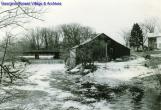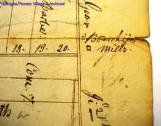1
In 1783, Upper Canada was virtually empty. By 1812, there were over 70 000 residents, mostly living along Lake Ontario.Georgina, on the southern shore of Lake Simcoe, was named in 1818 by the Lieutenant Governor of Upper Canada, Sir Peregrine Maitland, in honour of King George III.
After the war of 1812, officials at York (Toronto) were concerned with guarding the city's "back door," in case of more troubles with the Americans. To deal with this possibility, most of the land granted along the south shore of Lake Simcoe was to men with a military background, so that, should any trouble arise, there would be experienced men to head the local militias.
Originally, the township was closed to ordinary settlement. In 1816, William Bourchier retired from the British Royal Navy. He wished to seek his fortune in India, but knew that he was eligible for a substantial land grant in Upper Canada, and applied to enter the land south of Lake Simcoe reserved for "Privileged Persons." He was granted 1200 acres in 1818.
Realizing that he would lose his land if it was not settled, he enticed his younger brother, James, along with local acquaintances, the Comers and the Peregrines, to leave their lives in England behind and move to Upper Canada.
2
James O'Brien Bourchier (1797-1872)Circa 1870
Georgina Pioneer Village & Archives
 Credits:
Credits:Georgina Pioneer Village & Archives
3
Upon arriving, their first task was to dam the Black River. Once complete, a flue was built on the north and south banks of the river. The Bourchier brothers also constructed the first grist mill in the area on the river's north side. Prior to this, grain had to be carried to East Gwillimbury Township.4
James O'Brien Bourchier's Grist Mill, Sutton, Ontario1819-1835
Sutton, Ontario, Canada
 Credits:
Credits:Georgina Pioneer Village & Archives
Photographed between 1909-1926
5
James O'Brien Bourchier's Grist Mill, Sutton, Ontario1819-1835
Sutton, Ontario, Canada
 Credits:
Credits:Georgina Pioneer Village & Archives
Photographed 1970
6
On the south bank, a saw mill followed, and some time later, a woollen mill. There is some dispute regarding which building was constructed first - the grist mill or the saw mill. Regardless, with the benefit of the new saw mill, and the influx of new settlers skilled in the trades, the grist mill was reputedly refurbished in 1835.7
Woollen Mill, Sutton, Ontario1846-1851
Sutton, Ontario, Canada
 Credits:
Credits:Georgina Pioneer Village & Archives
Photographed 1970
8
IMAGE DETAILS:James O'Brien Bourchier's Woolen Mill was built between 1846 and 1851. Sometime in the first decade of the 20th century it was moved from the south bank of the Black River, up the hill to sit facing High Street. At this time, it was bricked over. Since then, it had served many purposes, including a cheese factory, town hall, and billiard hall. This photograph was taken in 1970. It was destroyed by arson in 1996.
9
James O'Brien Bourchier's Saw Mill, Sutton, Ontario1819-1835
Sutton, Ontario, Canada
 Credits:
Credits:Georgina Pioneer Village & Archives
Photographed late 19th Century
10
In 1822, William Bourchier sold Lots 1 & 2 in the 7th Concession of Georgina Township to his brother James O'Brien Bourchier. William married Amelia Jackson and left for India. He would not return until 1837, after the death of his wife. He died in 1844 and is buried beneath the present St. George's Churchyard in Jackson's Point, Georgina Township.11
As these three industries became increasingly established, the name Bourchier's Mills began to pop up on early 19th century books and maps. The Smith's Gazetteer of 1846, for example, lists Bouchier's Mills, or Sutton Mills, as the town's name. How the name Bourchier's Mills eventually became Sutton is not entirely clear. One story states that Sutton was the childhood home of another settler, William Kingdom Raines, who grew up on an estate in Wales called Sutton Lodge. Apparently, the name change occurred after a night of gambling between Mr. Bourchier and Mr. Raines, in which Mr. Raines proposed the name change if he won, which appears to have been the case. Over the years, the name appeared interchangeably, referred to as both Bourchier's Mills and Sutton (Mills). By the 1860s, however, the name Sutton had prevailed. It was eventually changed to Sutton West in order to distinguish it from Sutton, Quebec, thereby reducing confusion over mail delivery in the days before postal codes.12
Detail of an 1834 map of North Gwillimbury Township, Ontario, showing Bourchier's Mills1834
Sutton, Ontario, Canada
 Credits:
Credits:Georgina Pioneer Village & Archives
13
Around 1821, Bourchier's Mills had become a coveted destination for the area's farmers who were glad they no longer had to walk across two townships to get to the closest mill. As his mill prospered, James O'Brien Bourchier opened a general store on the south bank of the Black River, above the dam. Here, people bought or bartered for various goods, from ceramic ware to wheels of cheese. Within ten years of the store's opening, locals were also able to collect their mail at the store, since James had become Georgina's first Post Master. By 1833, he was also appointed a Magistrate of the Home District, and had shares in the first Steamer on Lake Simcoe, in addition to business interests in Collingwood and Chicago.14
James O'Brien Bourchier peddled his flour around Lake Simcoe18 February 1970
Sutton, Ontario, Canada
 Credits:
Credits:Alexander Bourchier Anderson, 1884-1971